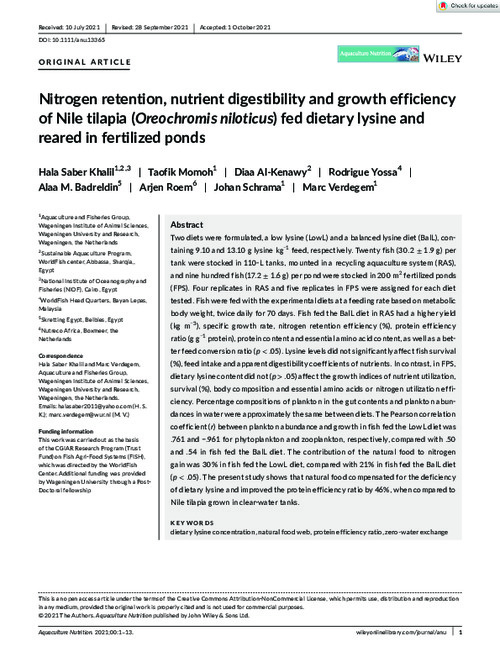Nitrogen retention, nutrient digestibility and growth efficiency of Nile tilapia (Oreochromis niloticus) fed dietary lysine and reared in fertilized ponds

Two diets were formulated, a low lysine (LowL) and a balanced lysine diet (BalL), containing 9.10 and 13.10 g lysine kg−1 feed, respectively. Twenty fish (30.2 ± 1.9 g) per tank were stocked in 110-L tanks, mounted in a recycling aquaculture system (RAS), and nine hundred fish (17.2 ± 1.6 g) per pond were stocked in 200 m2 fertilized ponds (FPS). Four replicates in RAS and five replicates in FPS were assigned for each diet tested. Fish were fed with the experimental diets at a feeding rate based on metabolic body weight, twice daily for 70 days. Fish fed the BalL diet in RAS had a higher yield (kg m−3), specific growth rate, nitrogen retention efficiency (%), protein efficiency ratio (g g−1 protein), protein content and essential amino acid content, as well as a better feed conversion ratio (p < .05). Lysine levels did not significantly affect fish survival (%), feed intake and apparent digestibility coefficients of nutrients. In contrast, in FPS, dietary lysine content did not (p > .05) affect the growth indices of nutrient utilization, survival (%), body composition and essential amino acids or nitrogen utilization efficiency. Percentage compositions of plankton in the gut contents and plankton abundances in water were approximately the same between diets. The Pearson correlation coefficient (r) between plankton abundance and growth in fish fed the LowL diet was .761 and −.961 for phytoplankton and zooplankton, respectively, compared with .50 and .54 in fish fed the BalL diet. The contribution of the natural food to nitrogen gain was 30% in fish fed the LowL diet, compared with 21% in fish fed the BalL diet (p < .05). The present study shows that natural food compensated for the deficiency of dietary lysine and improved the protein efficiency ratio by 46%, when compared to Nile tilapia grown in clear-water tanks.
Permalink
Date Available
Type
Publisher
Countries
ISSN
1353-5773,1365-2095
Copyright
CC-BY-NC-4.0
Research Themes
Topics
Language